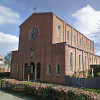Organ 3
The proposed replacement
From a musical point of view, Paris was an exciting place to be in the late nineteenth century. The opening of the new Opera house, the Opera Garnier in 1875 was one of the highlights of the era, and the city attracted the great composers of the day. Berlioz, Gounod, Offenbach, Delibes, Bizet, Massenet, Meyerbeer, Rossini, Charpentier, Gigout, Guilmant, Widor, Cesar Frank, Dukas, Debussy, Ravel, Saint-Saens, Faure and Satie were just some of the well-known names associated with Paris in this era. In addition to these, nearly all of the great composers of the day visited Paris. One of the highlights of any visit to Paris was to attend Mass at one of the large churches; the cathedral of Notre Dame, St Sulpice, St Clotilde, La Madeleine all were staffed by great musicians, and played organs built by Aristide Cavaille-Coll. He was acknowledged in his lifetime as the greatest organ-builder in Europe, and his reputation is no less now. Among those who sat on the organ-benches of Paris were Louis Lefebure-Wely at St Roch (1841-1846), La Madeleine (1846-1858) and St Sulpice (1863-1869); Cesar Franck at St Jean and St Francois (1842-1857) and St Clotilde (1857-1890); Felix Guilmant at Trinite (1871-1901); Charles Widor at St Sulpice (1870-1934). César Franck had ecstatically said of the rather modest Cavaillé-Coll instrument at l’Eglise St.-Jean-St.-Francois in Paris with words that summed up everything the builder was trying to do: “Mon nouvel orgue ? C’est un orchestre !” (“My new organ? It’s an orchestra!”).
When the young Eric Phillips (later the first Parish Priest at St Gregory’s) went to Paris, and went to Mass, it is likely that the organ he heard was build by Cavaillé-Coll — certainly at the occasion which first stirred the sense of priestly vocation in him, an ordination at St Sulpice — he would have heard the most famous of all the Cavaillé-Coll organs. It is appropriate that an instrument of the same style should be installed at St Gregory’s.
Aspiring organ-builders sought to work with “Le Maitre”; amongst them was August Gern. He was born in Berlin in 1837, and was apprenticed to Bucholz, himself a former pupil of Cavaillé-Coll. In 1859 Gern moved to Paris, and eventually became erecting foreman in the Cavaillé-Coll workshop. In 1865 he was sent to England to supervise the installation of the organ in the Carmelite Church in Kensington. While he was in England, the Franco-Prussian war broke out, and it proved impossible for him to return to Paris; in addition to this, he had met an English lady, so he remained in London, setting up in business, first off Tottenham Court Road, then in Notting Hill.
For the first years of his independent work, he was very much influenced by his former master, and many of his early instruments used pipework and other components from the Paris factory. Even his name-plate was modelled on that of his master.
One of these organs was in the redundant Anglican church at Grazeley in Berkshire. It carried “Grade One listing” from the British Pipe Organ Register. There are no grade one listed organs in Northampton. Although playable, it was in a very poor state of repair, but its specification is very similar to that of Farnborough Abbey, a masterpiece of organ-building by Cavaillé-Coll. In the process of moving, it would be fully restored.
